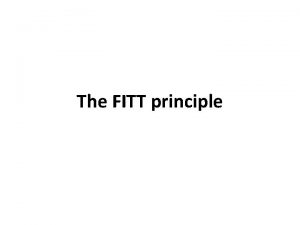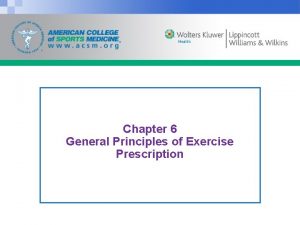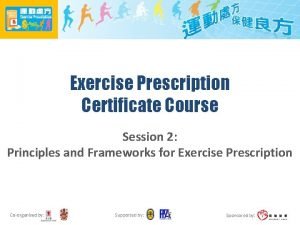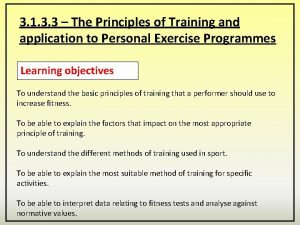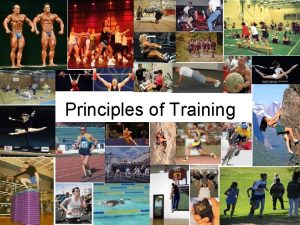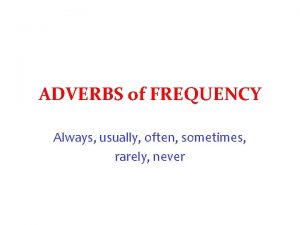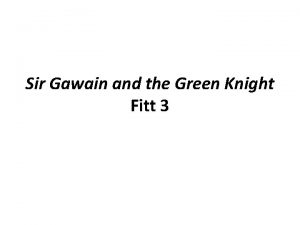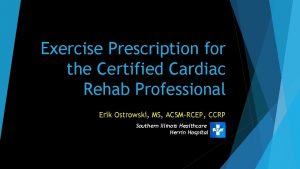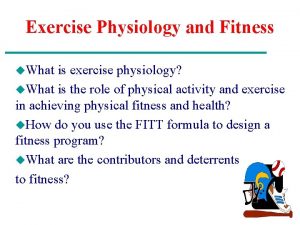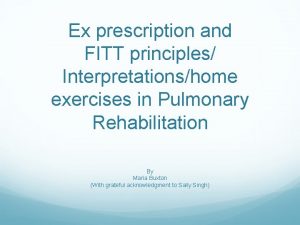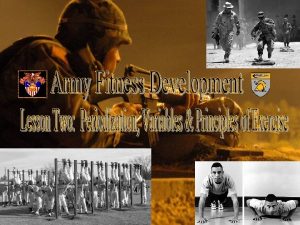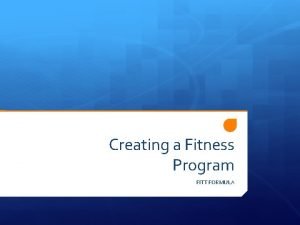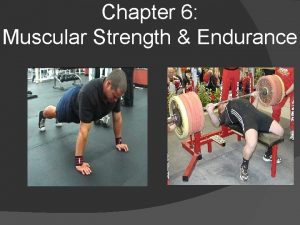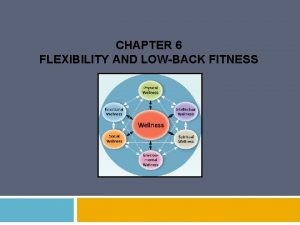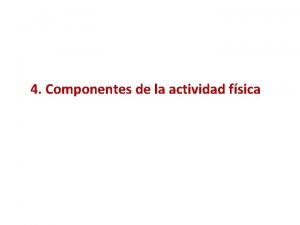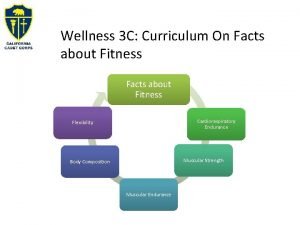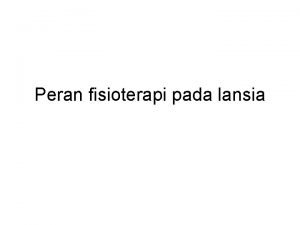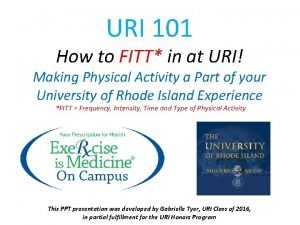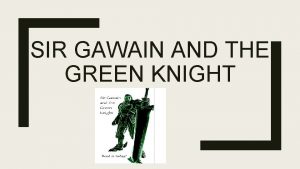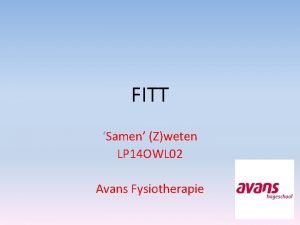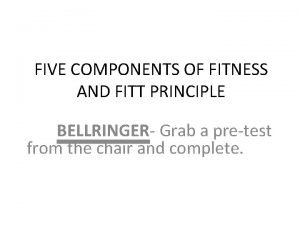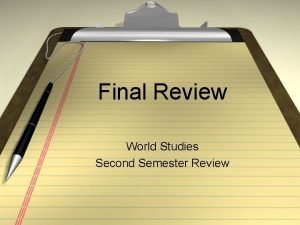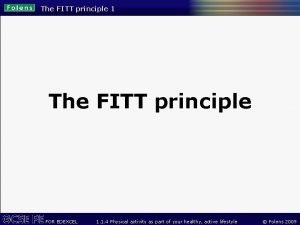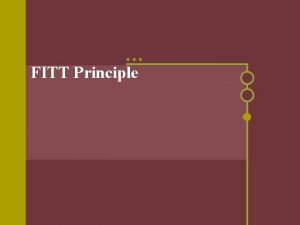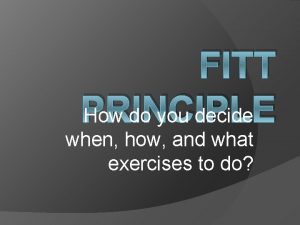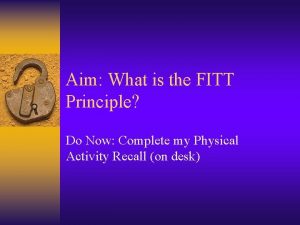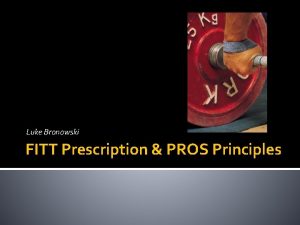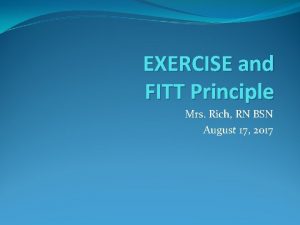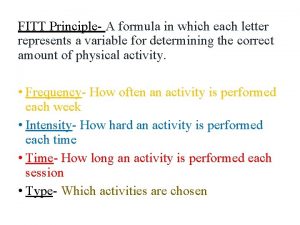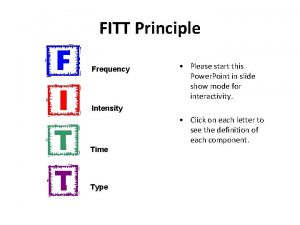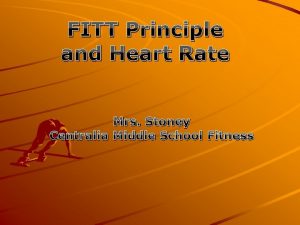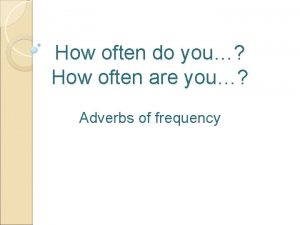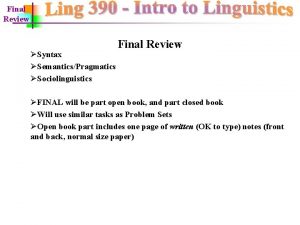Final Review FITT Principle Frequencyhow often you do








































- Slides: 40

Final Review

FITT Principle • Frequency-how often you do an exercise (number of days per week) • Intensity-how hard you are working (measured in heart rate or poundage) • Time-how long you are exercising • Type-what you are doing

Principles of… • Specificity-Training a group of muscles appropriately for a particular goal (ex. I want my biceps to get stronger so I do bicep curls not push-ups). • Progression-Gradually increasing the work of muscles over time. • Overload-Training muscles to perform at higher levels than they are accustomed.

Water • Is an essential nutrient • You should consume a minimum of 8 glasses of water a day • Can help prevent dehydration and kidney stones

How do I know if I am well-hydrated? • Urine has a pale yellow color (like straw) • Urine has no odor • I am not thirsty

Energy Source for aerobic exercise 20 minutes or more of continuous exercise In your heart rate zone burns: Fat

Energy Source for anaerobic exercise 1 -3 minutes of all out exercise burns: Sugar

6 health-related fitness components • • • Body Composition Cardiovascular Fitness Muscular Strength Muscular Endurance Flexibility Stress Management

Body composition-percentage of fat compared to muscle

Cardiovascular fitness-The ability of the heart , blood vessels, blood, and respiratory system to supply oxygen to the working muscles

Determining heart rate zone (220 -age) * 65% and (220 -age) * 85% Exercising between these 2 numbers for ____ minutes will give you a great cardiovascular workout.

Best places to take pulse • Carotid artery which is on your neck • Radial artery which is on your wrist

Flexibility-The ability to move a joint through its full range of motion

Muscular Endurance-Holding a muscle contraction for a long time

How do I improve my muscular endurance? • F = every other day • I = light weights/more repetitions (12 -20) • T = less than 30 second rest between sets • T = weight lifting

Muscular Strength-A persons ability to exert force

How do I gain muscular strength? • F = every other day • I = heavy weights/less repetitions (6 -8) • T = 1 -3 minute rest between sets • T = weight lifting

Stress Management-A persons ability to control and manage stress

Skill-related fitness components • • • Agility Balance Coordination Power Reaction time Speed

Skill-related fitness components • Agility-The ability to rapidly change directions of the whole body (soccer, tennis, basketball)

• Balance-The ability to maintain equilibrium while stationary or moving (gymnastics, dancing)

• Coordination-The ability to use the senses and body parts in order to perform motor tasks smoothly and accurately (all sports, archery)

• Power-The amount of force a muscle can exert (football)

• Reaction Time-The ability to respond quickly to stimuli (tennis, soccer, basketball)

• Speed-The amount of time it takes the body to perform a specific task (track, soccer, swimming

Concentric contractions • Concentric contraction is when the muscle is shortening or contracting. It is the 2 count of a lift. It is also known as flexion.

Eccentric contraction • Eccentric contraction is the 4 count of the lift. It is when the muscle is still contracted but lengthening. It is also known as extension. Which arm is doing a eccentric contraction?

Bicep curls-works the biceps What is the antagonistic muscle to the biceps?

Arnold press-Deltoids and triceps

Skull Crushers/French press Concentric phase Eccentric phase

Good Mornings-work erector spinae of lower back What exercise would work the antagonistic muscle to the erector spinae?

Hammer curls-works bicep muscle and forearms

Decline Bench press-puts more emphasis on your _______ (pectoralis major) chest muscles and triceps.

Incline Press-Works the upper chest and triceps

Seated Rows-works Latissimus Dorsi (Lats), Rhomboids, and biceps What type of athlete would benefit from this workout?

Bent over Rows-works Latissimus Dorsi (can be done with either an underhand or overhand grip

Bench Press-works pectoralis major and triceps

Hang cleans-Full body lift that works every muscle in your body-requires you keep the bar close to your anterior (front) the entire time

Push-ups work chest and triceps? Which picture is concentric? Eccentric? a b

Pull-ups strengthen which muscles? Biceps and latissimus dorsi
 Refers to the variety of training a performer undertake
Refers to the variety of training a performer undertake The fitt principle
The fitt principle Fitt principle for volleyball
Fitt principle for volleyball Fittbox
Fittbox Principle of reversibility
Principle of reversibility Fitt principle for badminton
Fitt principle for badminton Disadvantages of fartlek training
Disadvantages of fartlek training Fitt principle definition
Fitt principle definition Ap gov final review
Ap gov final review Always usually often sometimes never
Always usually often sometimes never Sir gawain and the green knight fitt 3
Sir gawain and the green knight fitt 3 Fitt-vp example
Fitt-vp example Fitt formula definition
Fitt formula definition What is the fitt formula
What is the fitt formula Fitt prescription
Fitt prescription Provirrbs
Provirrbs F i t t formula
F i t t formula Fitt chart
Fitt chart Fitt formula
Fitt formula 4 componentes de la actividad física
4 componentes de la actividad física What is the fitt formula
What is the fitt formula Crocodile scots poem
Crocodile scots poem Peran fisioterapi pada lansia
Peran fisioterapi pada lansia Fitt for running
Fitt for running Read the excerpt from sir gawain and the green knight.
Read the excerpt from sir gawain and the green knight. Fitt factoren
Fitt factoren Gym fitt
Gym fitt World history spring final exam review answers
World history spring final exam review answers World history and geography final exam study guide
World history and geography final exam study guide Spanish final exam review packet answer key
Spanish final exam review packet answer key Pltw human body systems final exam
Pltw human body systems final exam Poe practice test answer key
Poe practice test answer key Ied final exam review
Ied final exam review World history semester 2 final review packet
World history semester 2 final review packet World history semester 1 exam
World history semester 1 exam Principles of business final exam answer key
Principles of business final exam answer key Spanish 2 final exam review answer key
Spanish 2 final exam review answer key Environmental science final
Environmental science final World history final exam review
World history final exam review Us history semester 2 final exam review
Us history semester 2 final exam review Algebra 1 semester 2 final exam
Algebra 1 semester 2 final exam
